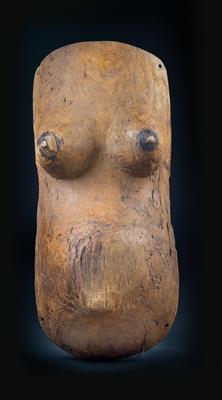Makonde, Tanzania, Mozambique: A female ‘Ndimu’ body mask.

In the whole of Africa, only two peoples have produced these body masks and danced with them: the Yoruba in Nigeria (only female body masks) and the Makonde in Tanzania and Mozambique (female and male). Among the Makonde, male dancers perform with these body masks and matching helmet or face masks during the big ‘Mapiko dance feasts’ (see cat. no. 139). This female body-mask, called ‘Ndimu’, depicts a young, pregnant woman. The dancer uses it to represent a woman’s labour pains. The present ‘Ndimu’ mask is visibly old, carved in wood, light-brown and black on the outside, and dyed black on the inside. It displays typical tribal scarification marks in relief on either side of the abdomen. With good, old usage patina and minor age damage (minor tears, insect damage?). First half of the 20th century; H: 52.5 cm. (ME)
Provenance: Austrian private collection.
Literature: 'Tanzania' by Marc. L. Felix & Maria Kecskesi, ill. 273 bis 277; 'Shangaa. Art of Tanzania' by Gary van Wyk, ill. fig. 3.1, fig. 3.6.
Esperto: Prof. Erwin Melchardt
 Prof. Erwin Melchardt
Prof. Erwin Melchardt
+43-1-515 60-465
erwin.melchardt@dorotheum.at
24.03.2014 - 16:00
- Stima:
-
EUR 4.000,- a EUR 5.000,-
Makonde, Tanzania, Mozambique: A female ‘Ndimu’ body mask.
In the whole of Africa, only two peoples have produced these body masks and danced with them: the Yoruba in Nigeria (only female body masks) and the Makonde in Tanzania and Mozambique (female and male). Among the Makonde, male dancers perform with these body masks and matching helmet or face masks during the big ‘Mapiko dance feasts’ (see cat. no. 139). This female body-mask, called ‘Ndimu’, depicts a young, pregnant woman. The dancer uses it to represent a woman’s labour pains. The present ‘Ndimu’ mask is visibly old, carved in wood, light-brown and black on the outside, and dyed black on the inside. It displays typical tribal scarification marks in relief on either side of the abdomen. With good, old usage patina and minor age damage (minor tears, insect damage?). First half of the 20th century; H: 52.5 cm. (ME)
Provenance: Austrian private collection.
Literature: 'Tanzania' by Marc. L. Felix & Maria Kecskesi, ill. 273 bis 277; 'Shangaa. Art of Tanzania' by Gary van Wyk, ill. fig. 3.1, fig. 3.6.
Esperto: Prof. Erwin Melchardt
 Prof. Erwin Melchardt
Prof. Erwin Melchardt
+43-1-515 60-465
erwin.melchardt@dorotheum.at
|
Hotline dell'acquirente
lun-ven: 10.00 - 17.00
kundendienst@dorotheum.at +43 1 515 60 200 |
| Asta: | Tribal Art |
| Tipo d'asta: | Asta in sala |
| Data: | 24.03.2014 - 16:00 |
| Luogo dell'asta: | Wien | Palais Dorotheum |
| Esposizione: | 18.03. - 24.03.2014 |
